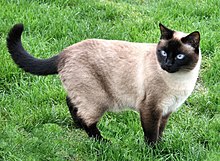Point coloration

Points are specific areas of an animal coat that are colored differently from the main body colorations. Typical point coloration is represented by a pale body color and relatively darker extremities, such as face, ears, feet, tail, and scrotum.[1] It is most recognizable in the coloration of Siamese cats, but colored points can be found in many mammal species and some points are lighter than the main body color.
Small animals
[edit]Dark point coloration patterns are seen in cats, dogs (rare), fancy rats, guinea pigs, and rabbits and is called acromelanism or "colorpoint".
Colored points in dogs are lighter than the body coat, and usually tan. Tan points include small patches above the eyes and on the cheeks, the sides of the muzzle, front of neck and chest, lower legs and insides of legs, and under the tail.[2][3]
- Colorpoint in small animals
-
Cat
-
Fancy rat
-
Guinea pig
-
Rabbit
-
Dog with tan points
Horses
[edit]The name given to a horse's coat color depends on the color of both the points and the body. Bay horses have a reddish-brown body with black points, which include the mane, tail, lower legs, and ear rims.[4]
In horses, point coloration is most often produced by the action of the agouti gene. It acts on the extension gene, when present, to suppress black color to all but the extremities of the horse; the legs, mane, tail and tips of the ears. If the extension gene is not present, the effect of agouti is not visible, as there is no black color present to suppress.
Other genes white markings may affect a horse's coat color in addition to agouti, and if present, can further alter or suppress black hair color and may mask any point coloration. In particular, Gray horses are born dark and lighten with age; if born bay, they will eventually lose point coloration as the body hair silvers with age, though often the points are the slowest areas of the body to go gray.
Point coloration may also be visible on horses with other dilution genes that act upon a bay base coat. These include:
- The cream gene, an incomplete dominant, that when heterozygous produces Buckskin. When homozygous, even point coloration is mostly suppressed, the color is called perlino, and some individuals may have slightly redder hair at the traditional point coloration locations.
- The Champagne gene, which on a bay base produces Amber Champagne.
A dilution gene that produces what looks like point coloration, but from a completely different genetic mechanism is the dominant Dun gene, which dilutes the color of the body coat but not the points, including primitive markings—a dorsal stripe down the back and, less often, horizontal striping on the upper legs. On a bay base coat the dun gene leaves black points, producing a Bay Dun or "Zebra" Dun. But the gene also leaves the points dark when it appears with other base colors. These include the “blue dun” or grullo, which has a black base coat, and the red dun, which has a chestnut base coat.
Similarly, darker coloration at the points is also preserved in horses with the roan gene, a patterning gene, producing a body coat of mingled white and dark hairs, but leaving the points the darker base color in all horses, not just those carrying agouti.
Most other genes that produce spotting patterns or white markings allow point coloration produced by agouti to show except where masked by white depigmentation. There are not always separate names for a pattern over a bay base coat, but one exception is the Bay pinto, sometimes called ”tricoloured”.
Donkeys
[edit]
In donkeys, the term "points" refers to the muzzle, rings around the eyes, belly, and upper inner legs, which are usually light in color. The mane, tail, and ear rims are referred to as "trim" and roughly correspond to the "points" of horses. Most donkeys have light points. The coat colors without light points may be called "no light points", "dark points", or "black points". Dark points are caused by a recessive allele of agouti found in Normand and Miniature donkeys. The light areas may vary in extent, with some donkeys having a dark nose but with light areas on the insides of the legs.[4]
Sheep
[edit]
Some breeds of sheep exhibit point coloration with a white fleece and colored head and legs, usually black.[5] Sheep breeds with black points include: Clun Forest, Dorset Down, Hampshire Down, Norfolk Horn, Oxford Down, Shropshire, Suffolk, and Valais Blacknose. Instead of black, American Tunis sheep have a red face, and Wensleydale sheep have a blue-grey face.
References
[edit]- ^ Steeh, Judith A. (1984). Cat breeds. Gallery Books. p. 10. ISBN 0831712023. OL 24961512M.
The colorpoint pattern consists of a basic body color and a contrasting point color. The points appear on the cooler extremities of the cat, and have sometimes been called 'temperature points.' The points, which must be well-defined, of a contrasting color, and of the same color density, are the mask, ears, feet, tail, and sex organs. There should not be any ticking or white hairs in the points. The mask should cover the entire face, including the whisker pads, and be connected to the ears by 'tracings' ; it should not, however, extend over the top of the head.
- ^ Dreger, Dayna L.; Schmutz, Sheila M. (2011). "A SINE Insertion Causes the Black-and-Tan and Saddle Tan Phenotypes in Domestic Dogs". Journal of Heredity. 102 (Suppl 1): S11–S18. doi:10.1093/jhered/esr042. PMID 21846741.
- ^ Chappell, Jess. "The Agouti Series : Tan Points". Dog Coat Color Genetics.
- ^ a b Sponenberg, D. Phillip; Bellone, Rebecca (2017). Equine Color Genetics (4 ed.). Wiley Blackwell. pp. 5, 6, 23, 253, 275.
- ^ "Suffolk Breed Standards" (PDF). United Suffolk Sheep Association. Retrieved September 28, 2024.










